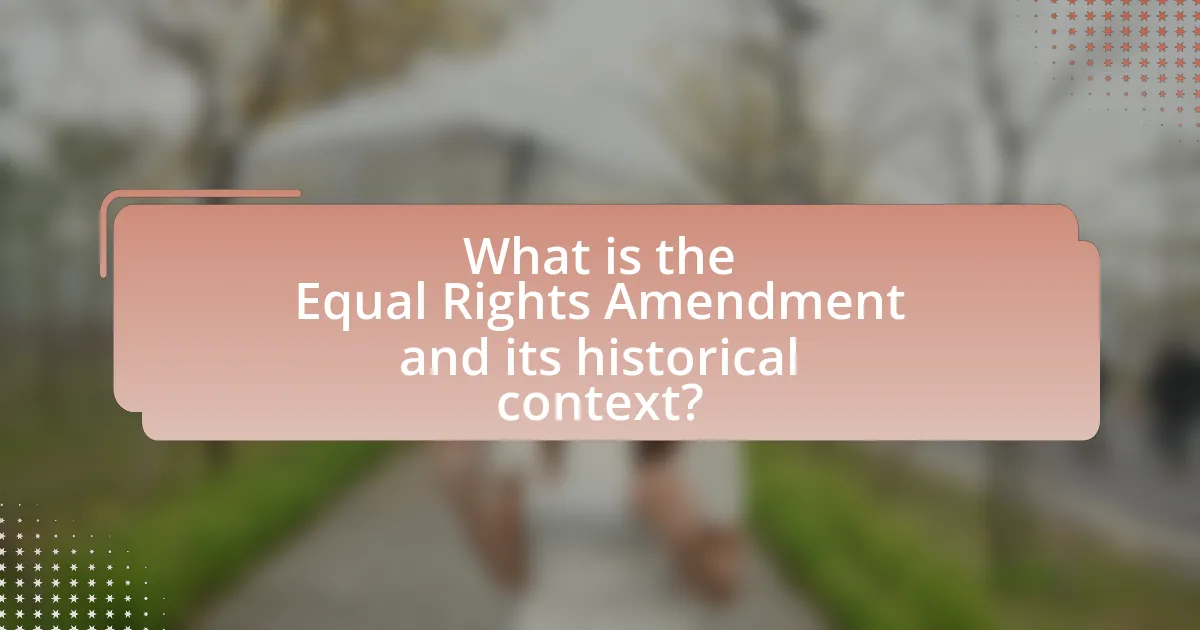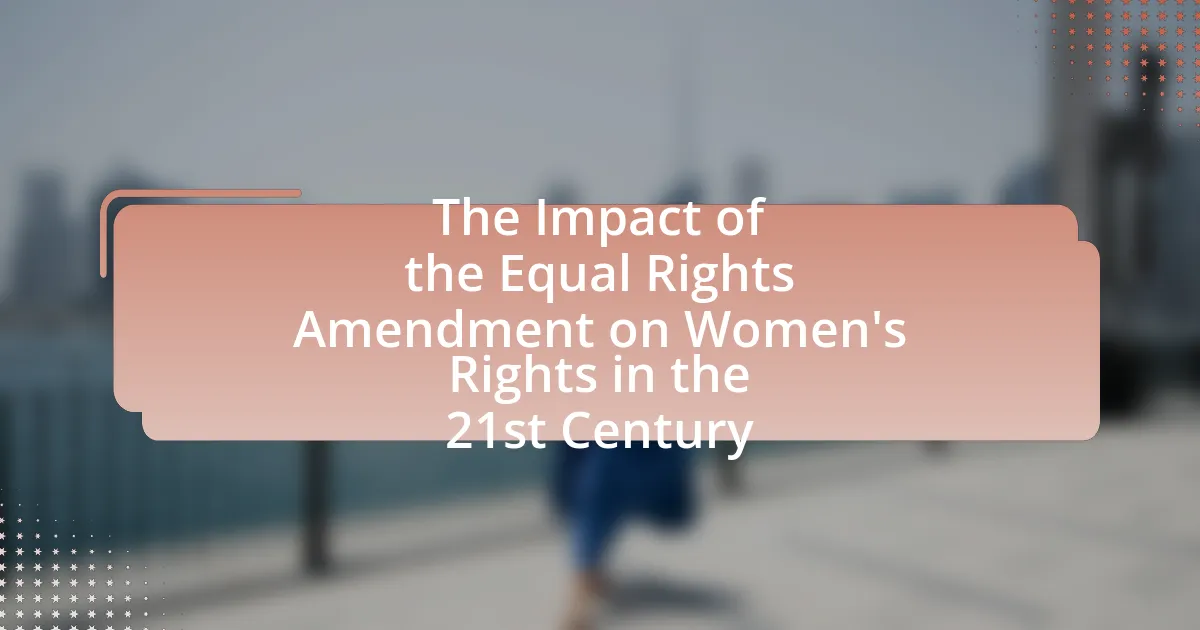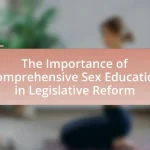The Equal Rights Amendment (ERA) is a proposed constitutional amendment aimed at ensuring equal legal rights for all American citizens regardless of sex. Originating from the early 20th-century women’s rights movement, the ERA has faced significant historical context, including the women’s suffrage movement and the second-wave feminist movement. Despite being passed by Congress in 1972 and ratified by 38 states, its legal status remains uncertain due to ongoing debates and challenges. The article explores the ERA’s historical background, key advocates, current status, and its influence on women’s rights in the 21st century, including workplace equality and reproductive rights, while also addressing the challenges and opposition it faces today.

What is the Equal Rights Amendment and its historical context?
The Equal Rights Amendment (ERA) is a proposed amendment to the United States Constitution aimed at guaranteeing equal legal rights for all American citizens regardless of sex. Introduced in Congress in 1923, the ERA was designed to eliminate legal distinctions between men and women in matters of divorce, property, employment, and other areas. Its historical context includes the women’s suffrage movement, which culminated in the 19th Amendment in 1920, granting women the right to vote. The ERA gained significant momentum during the 1960s and 1970s, coinciding with the second-wave feminist movement, which advocated for gender equality in various aspects of society. Despite passing Congress in 1972, the ERA has not been ratified by the necessary 38 states, reflecting ongoing debates about gender equality and women’s rights in the United States.
How did the Equal Rights Amendment originate?
The Equal Rights Amendment (ERA) originated from the early 20th-century women’s rights movement, specifically in 1923 when Alice Paul first introduced it to Congress. The amendment aimed to guarantee equal legal rights for all American citizens regardless of sex. Its introduction was a response to the ongoing legal inequalities faced by women, particularly after the passage of the 19th Amendment in 1920, which granted women the right to vote but did not address broader issues of gender equality. The ERA was reintroduced in every session of Congress until it was finally passed in 1972, reflecting a growing recognition of women’s rights as a critical social issue.
What were the key events leading to the proposal of the Equal Rights Amendment?
The key events leading to the proposal of the Equal Rights Amendment (ERA) include the women’s suffrage movement, which culminated in the 19th Amendment’s ratification in 1920, granting women the right to vote. Following this, in 1923, Alice Paul introduced the ERA to ensure equal legal rights for all citizens regardless of sex. The post-World War II era saw increased advocacy for women’s rights, highlighted by the formation of the National Organization for Women (NOW) in 1966, which pushed for the ERA’s passage. The growing feminist movement in the 1960s and 1970s, alongside the civil rights movement, further emphasized the need for gender equality, leading to renewed efforts to pass the ERA, which was finally approved by Congress in 1972.
Who were the main advocates for the Equal Rights Amendment?
The main advocates for the Equal Rights Amendment included Alice Paul, who was a prominent suffragist and the original author of the amendment, and Betty Friedan, a leading figure in the feminist movement and co-founder of the National Organization for Women. Their efforts were crucial in promoting the amendment, which aimed to guarantee equal legal rights for all American citizens regardless of sex. Alice Paul’s advocacy began in the early 20th century, while Betty Friedan’s involvement gained momentum in the 1960s, highlighting the ongoing struggle for gender equality in the United States.
What is the current status of the Equal Rights Amendment?
The current status of the Equal Rights Amendment (ERA) is that it has been ratified by 38 states, meeting the requirement for adoption, but its legal status remains uncertain due to a deadline set by Congress in 1972 that has since expired. Despite this, advocates argue that the amendment should still be considered valid, citing the recent ratifications by states such as Virginia in 2020. Legal challenges and congressional actions continue to shape the debate over its implementation and recognition in the Constitution.
How many states have ratified the Equal Rights Amendment?
Thirty-eight states have ratified the Equal Rights Amendment. This number is significant because it represents the threshold required for the amendment to be added to the U.S. Constitution, as established by Article V of the Constitution. The Equal Rights Amendment was first proposed in 1923 and was passed by Congress in 1972, aiming to guarantee equal legal rights for all American citizens regardless of sex.
What legal challenges has the Equal Rights Amendment faced?
The Equal Rights Amendment (ERA) has faced significant legal challenges primarily related to its ratification process and the deadline for states to approve it. Initially proposed in 1923 and passed by Congress in 1972, the ERA required ratification by 38 states within a seven-year timeframe, which was later extended to 1982. By that deadline, only 35 states had ratified the amendment, leading to legal disputes over whether the deadline was binding and whether states could rescind their ratification. In 2020, Virginia became the 38th state to ratify the ERA, prompting further legal questions about the amendment’s validity and the implications of the expired deadline. These challenges have resulted in ongoing litigation and debates regarding the constitutional status of the ERA and its potential enforcement.
How has the Equal Rights Amendment influenced women’s rights in the 21st century?
The Equal Rights Amendment (ERA) has significantly influenced women’s rights in the 21st century by reinforcing the legal framework for gender equality in various aspects of life, including employment, education, and reproductive rights. The ERA, which aims to guarantee equal legal rights for all American citizens regardless of sex, has inspired numerous state-level initiatives and court cases that challenge gender discrimination. For instance, the ongoing discussions surrounding the ERA have led to increased public awareness and advocacy for women’s rights, as evidenced by the rise in grassroots movements and legislative efforts aimed at closing the gender pay gap and combating workplace discrimination. Additionally, the ERA’s principles have been cited in landmark Supreme Court cases, such as United States v. Virginia (1996), which ruled against gender discrimination in military academies, further solidifying its impact on women’s rights in contemporary society.
What specific rights have been impacted by the Equal Rights Amendment?
The Equal Rights Amendment (ERA) specifically impacts rights related to gender equality, including the right to equal pay, the right to be free from gender-based discrimination in employment, and the right to equal treatment under the law. The ERA aims to eliminate legal distinctions between men and women, thereby reinforcing protections against discrimination in various sectors such as education, healthcare, and family law. Historical context shows that despite existing laws, women have faced systemic inequalities; for instance, women earn approximately 82 cents for every dollar earned by men, highlighting the ongoing need for constitutional guarantees of equality.
How has the Equal Rights Amendment affected workplace equality?
The Equal Rights Amendment (ERA) has significantly advanced workplace equality by explicitly prohibiting discrimination based on sex. This constitutional guarantee has empowered women to challenge discriminatory practices in hiring, promotions, and pay, leading to increased legal protections and workplace policies that promote gender equality. For instance, the passage of the ERA would reinforce existing laws like the Equal Pay Act of 1963 and Title VII of the Civil Rights Act of 1964, which already address gender discrimination but lack the constitutional backing that the ERA would provide. Studies show that states with strong equal rights protections have seen greater improvements in women’s labor force participation and wage equality, demonstrating the ERA’s potential to further enhance workplace equality.
What changes in reproductive rights can be attributed to the Equal Rights Amendment?
The Equal Rights Amendment (ERA) has contributed to significant changes in reproductive rights by reinforcing the legal framework for gender equality, which has influenced court rulings and legislation regarding women’s reproductive health. The ERA’s emphasis on equal protection under the law has been cited in various legal cases, such as Whole Woman’s Health v. Hellerstedt (2016), where the Supreme Court struck down restrictive abortion laws, affirming that such regulations cannot impose an undue burden on women. Additionally, the ERA has inspired advocacy for policies that support reproductive autonomy, including access to contraception and abortion services, thereby promoting women’s rights in the context of reproductive health.
How do different demographics perceive the Equal Rights Amendment?
Different demographics perceive the Equal Rights Amendment (ERA) in varied ways, influenced by factors such as age, gender, race, and political affiliation. For instance, surveys indicate that younger individuals, particularly women, tend to support the ERA more than older generations, reflecting a shift in societal values towards gender equality. Additionally, women of color often express stronger support for the ERA, as they recognize its potential to address intersectional inequalities. Political affiliation also plays a significant role; Democrats generally show higher levels of support for the ERA compared to Republicans, with recent polls revealing that approximately 70% of Democrats favor the amendment, while support among Republicans is notably lower. These perceptions highlight the complex landscape of public opinion surrounding the ERA, shaped by demographic factors and societal context.
What are the views of younger generations on the Equal Rights Amendment?
Younger generations generally support the Equal Rights Amendment (ERA), viewing it as a necessary step toward achieving gender equality. Surveys indicate that approximately 70% of millennials and Gen Z individuals believe that the ERA is essential for ensuring equal rights under the law, reflecting a strong commitment to gender equity. This support is often rooted in a broader awareness of social justice issues and a desire for legal protections against gender discrimination, as highlighted by organizations like the American Association of University Women, which emphasizes the importance of the ERA in addressing systemic inequalities.
How do racial and ethnic differences influence perspectives on the Equal Rights Amendment?
Racial and ethnic differences significantly influence perspectives on the Equal Rights Amendment (ERA) by shaping the priorities and experiences of various groups. For instance, women of color often emphasize intersectionality, highlighting how race, gender, and class intersect to affect their rights and opportunities, which can lead to a more critical view of the ERA as it may not fully address their unique challenges. Research indicates that Black and Latina women are more likely to advocate for comprehensive policies that address systemic inequalities, suggesting that they may perceive the ERA as insufficient if it does not encompass broader social justice issues. Additionally, historical contexts, such as the exclusion of women of color from mainstream feminist movements, contribute to skepticism about the ERA’s ability to deliver equitable benefits across all racial and ethnic groups.
What challenges remain for the Equal Rights Amendment in advancing women’s rights?
The Equal Rights Amendment (ERA) faces significant challenges in advancing women’s rights, primarily due to its lack of ratification by the required number of states and ongoing legal and political opposition. As of October 2023, the ERA has not been fully ratified, with only 38 states needed for it to become part of the Constitution, and five states have rescinded their ratification. Additionally, there are legal disputes regarding the deadline for ratification, which was originally set for 1982, creating uncertainty about its future. Political resistance from various groups also hampers progress, as some argue that the ERA could undermine existing legal protections for women. These challenges collectively hinder the ERA’s potential to solidify gender equality in the legal framework of the United States.
What opposition does the Equal Rights Amendment face today?
The Equal Rights Amendment faces opposition primarily from conservative groups and some lawmakers who argue that it could undermine existing legal protections for women, such as those related to single-sex facilities and military service. These opponents claim that the amendment could lead to unintended consequences, including the elimination of gender-specific laws that they believe are necessary for women’s safety and privacy. Additionally, some critics assert that the amendment is unnecessary, citing existing constitutional protections against gender discrimination, such as the Equal Protection Clause of the 14th Amendment.
What are the main arguments against the Equal Rights Amendment?
The main arguments against the Equal Rights Amendment (ERA) include concerns about potential negative impacts on existing laws, the belief that it is unnecessary due to existing legal protections, and fears regarding the implications for family law and military service. Critics argue that the ERA could undermine laws that protect women, such as those related to maternity leave and alimony, by eliminating gender-specific protections. Additionally, opponents assert that women already have equal rights under the Constitution, citing the 14th Amendment’s Equal Protection Clause as sufficient. Furthermore, some express apprehension that the ERA could lead to women being drafted into military service, which they view as a significant societal change.
How do political divisions impact the future of the Equal Rights Amendment?
Political divisions significantly hinder the future of the Equal Rights Amendment (ERA) by creating legislative gridlock and differing priorities among lawmakers. The ERA, which aims to guarantee equal legal rights for all American citizens regardless of sex, faces opposition primarily along partisan lines, with many Republican lawmakers expressing resistance to its ratification. This division has resulted in stalled efforts to secure the necessary support from state legislatures, as evidenced by the failure to achieve the required three-fourths majority for ratification since the amendment was first proposed in 1923. Additionally, political factions often prioritize other issues over gender equality, further complicating the ERA’s path forward.
What strategies can be employed to promote the Equal Rights Amendment?
To promote the Equal Rights Amendment (ERA), grassroots mobilization and coalition-building are essential strategies. Grassroots mobilization involves organizing community events, rallies, and educational campaigns to raise awareness about the importance of the ERA, which aims to guarantee equal legal rights for all American citizens regardless of sex. Coalition-building with various organizations, including women’s rights groups, labor unions, and civil rights organizations, can amplify the message and create a united front advocating for the amendment. Historical evidence shows that successful movements, such as the civil rights movement, utilized similar strategies to achieve legislative goals, demonstrating their effectiveness in garnering public support and influencing policymakers.
How can grassroots movements support the Equal Rights Amendment?
Grassroots movements can support the Equal Rights Amendment (ERA) by mobilizing community engagement, raising awareness, and advocating for legislative action. These movements can organize campaigns that educate the public about the importance of the ERA, highlighting its potential to ensure equal rights regardless of sex, which is crucial for advancing women’s rights in the 21st century. For instance, grassroots organizations can host events, utilize social media platforms, and collaborate with local leaders to amplify their message. Historical evidence shows that grassroots activism has been pivotal in past social movements, such as the civil rights movement, demonstrating its effectiveness in influencing policy and public opinion.
What role do educational initiatives play in advancing the Equal Rights Amendment?
Educational initiatives play a crucial role in advancing the Equal Rights Amendment by raising awareness and fostering understanding of gender equality issues. These initiatives educate the public about the historical context and significance of the Amendment, which aims to eliminate discrimination based on sex. For instance, campaigns and programs that inform citizens about the legal implications of the Amendment can mobilize support and encourage advocacy efforts. Research indicates that states with robust educational programs on gender equality see higher public support for the Amendment, demonstrating a direct correlation between education and advocacy effectiveness.
What practical steps can individuals take to support women’s rights through the Equal Rights Amendment?
Individuals can support women’s rights through the Equal Rights Amendment by advocating for its ratification and raising awareness about its importance. Engaging in grassroots campaigns, contacting legislators to express support, and participating in local and national organizations focused on women’s rights can amplify efforts. Additionally, educating oneself and others about the historical context and current implications of the Equal Rights Amendment fosters informed discussions. According to the National Organization for Women, the Equal Rights Amendment would guarantee equal legal rights for all American citizens regardless of sex, addressing systemic inequalities that persist today.


